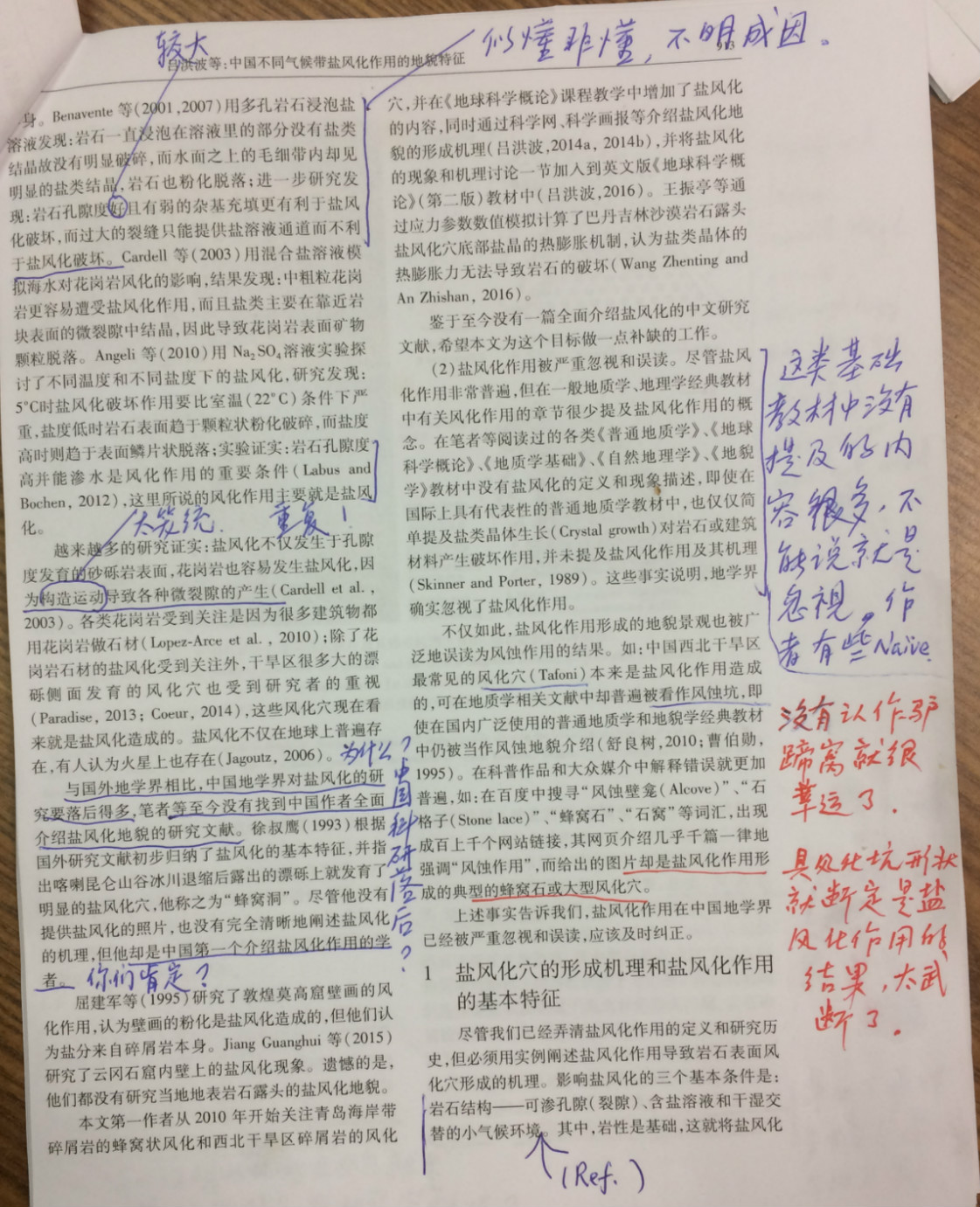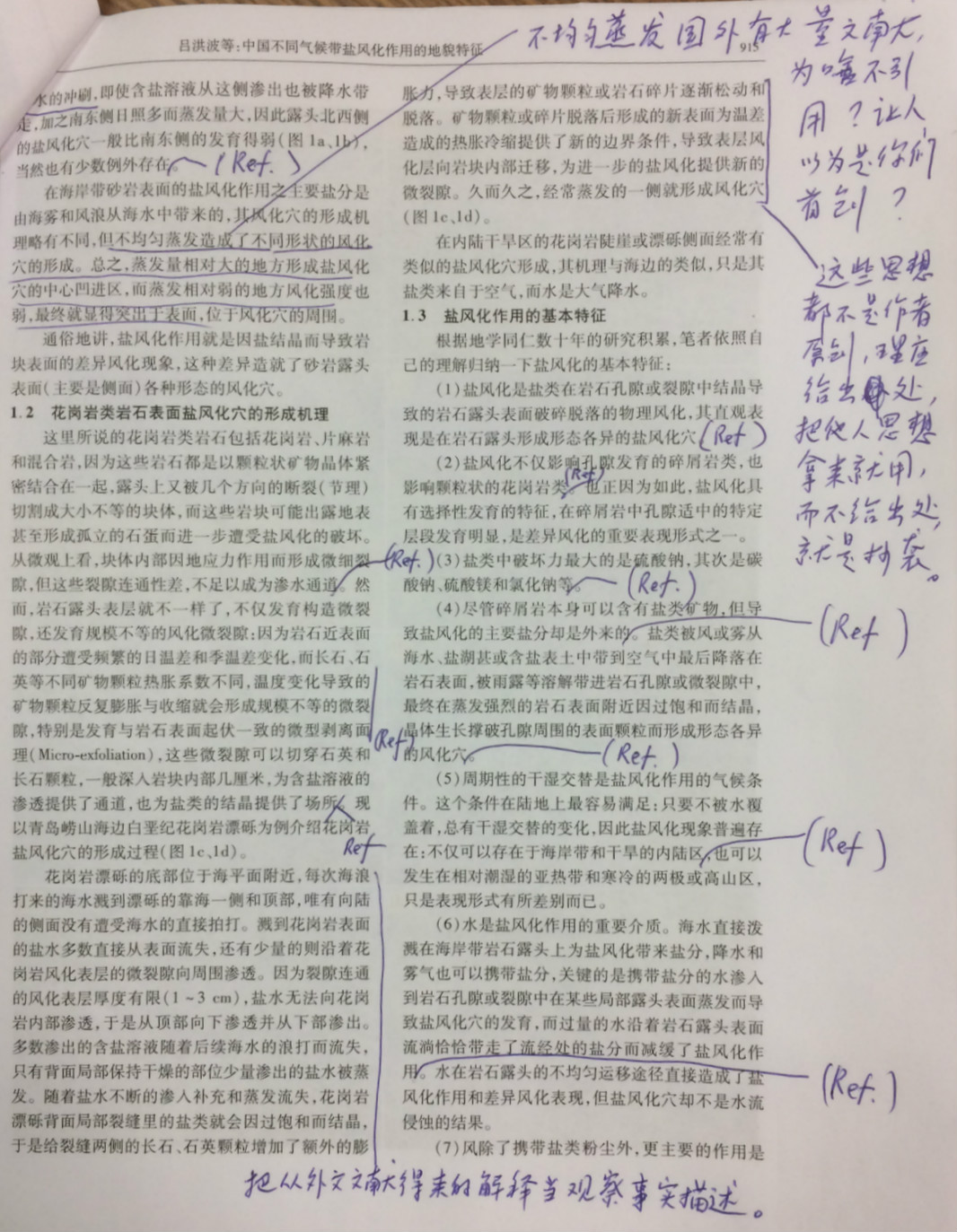学术争鸣: 对吕洪波等发表于《地质论评》(2017年7月)...
学术争鸣: 对吕洪波等发表于《地质论评》(2017年7月)文章的讨论 吕洪波等5人联名在《地质论评》地63卷第4期(2017年7月)发表了一篇名为“中国不同气候带盐风化的地貌特征”的“论文”。之后,这些作者在中国科学网上宣传说自己的成果应该写进地质学的教科书。 可是,一句一句读完这篇文章,并没有发现任何原创性的内容, 所有关键性结论皆可从西方作者已发表的论文中找出。本是一篇读了几篇西方英文文献后写出的嫩涩的读书笔记,做些理解性综述, 可作者急功近利,偏偏作为原创性论文发表, 不免有抄袭之嫌。明明该表明结论出处的地方, 作者却隐而不引, 误导读者以为是他们的原创。这篇文章把西方学者的研究结论硬套到中国几个地区的露头上, 而没有实实在在地研究盐是否真的出现、如何出现在所在露头,并怎样使得岩石发生碎裂,把需要讨论的猜想当着已经观察到了的事实描述, 作者们对科研的真谛似乎缺少正确的了解。            下列文献本该引用,可是吕洪波等人却没有引用, 而他们文章的结论却从这些文献不难发现。 Johnston J. H. (1973) Saltweathering processes in the McMurdo Dry Valley regions of South Victoria Land,Antarctica, New Zealand Journal of Geology and Geophysics, 16:2, 221-224, DOI:10.1080/00288306.1973.10431454 Hejl Ewald, 2005. A pictorial studyof tafoni development from the 2nd millennium BC . Geomorphology 64 (2005) 87 –95. Matsukura, Y. and Tanaka, Y., 2000:Effect of rock hardness and moisture content on tafoni weathering in thegranite of Mount Doeg-sung, Korea. Geogr. Ann., 82 A (1): 59–67. Brandmeier, M. , J. Kuhlemann, I.Krumrei, A. Kappler and P.W. Kubik, 2011. New challenges for tafoni research. Anew approach to understand processes and weathering rates. Earth Surf.Process. Landforms 36, 839–852。 MELLOR, J. SHORT AND S. J. KIRKBY.1997. TAFONI IN THE EL CHORRO AREA, ANDALUCIA, SOUTHERN SPAIN. Earth surf.process. landforms, 22, 817–833 (1997)。 HUININK, H. P., L. PEL AND K.KOPINGA. 2004. SIMULATING THE GROWTH OF TAFONI. Earth Surf. Process. Landforms 29, 1225–1233 (2004)。 Bradley WC, Hutton JT, Twidale CR.1978. Role of salts in development of granitic tafoni, South Australia. Journalof Geology 86: 647–654. Evans IS. 1970. Saltcrystallization and rock weathering: a review. Revue de Geomorphologiedynamique 19: 153–177. Mustoe GE. 1983. Cavernous weatheringin the Capitol Reef desert, Utah. Earth Surface Processes and Landforms 8:517–526. Mottershead DN, Pye K. 1994. Tafonion coastal slopes, South Devon, UK. Earth Surface Processes and Landforms 19:543–563. Prata AT, Sparrow EM. 1985. Forcedconvection evaporation from a cavity containing liquid whose surface is curvedby capillarity: computations in interlocking rectangular and cylindricaldomains. Numerical Heat Transfer 8: 667–688. Scherer GW. 1999. Crystallizationin pores. Cement and Concrete Research 29: 1347–1358. Winkler EM, Wilhelm EJ. 1970.Saltburst by hydration pressure in architectural stone in urban atmosphere.Bulletin Geological Society of America 81: 567–572. Young, A. R., 1987, Salt as anagent in the development of cavernous weathering: Geology, v. 15, p. 962–966. Mustoe, G., 2010. Biogenic originof coastal honeycomb Weathering. Earth Surf. Process. Landforms (2010). DOI:10.1002/esp.1931 Kaelin M. Groom, Casey D. Allen,Lisa Mol, Thomas R. Paradise, Kevin Hall. 2015. Defining tafoni: Re-examiningterminological ambiguity for cavernous rock decay phenomena. Progress inPhysical Geography, 2015, Vol. 39(6) 775–793 吕洪波等在文章的引言里说“欢迎地学同仁批评指正”, 作为博士在读的学生,本人斗胆对这些老前辈的文章做些讨论, 希望他们是真心地“欢迎地学同仁批评指正”的。 吕洪波等的读书笔记能作为原创性科学论文发表, 说明《地质论评》的审稿系统出现问题, 稿子没有送到真正的专家手中评审。而这篇文章的第三作者正是该期刊的常务副主编。作者与编辑的“合作”可能使得该稿没有经过正常的严格的审稿程序。 西方教科书介绍盐风化(盐结晶作用)比比皆是,那是吕洪波、苏德辰等人宣称为“盐风化作用在地学界一直被忽视”。 Salt-crystal growth (http://en.wikipedia.org/wiki/Weathering) Salt crystallization, otherwise known as haloclasty,causes disintegration of rocks when saline solutions seep into cracks and joints inthe rocks and evaporate, leaving salt crystals behind. These salt crystals expand asthey are heated up, exerting pressure on the confining rock. Salt crystallization may also take place when solutions decompose rocks (for example, limestone and chalk) to form salt solutions of sodium sulfate or sodiumcarbonate, of which themoisture evaporates to form their respective salt crystals. The salts which have proved most effective in disintegratingrocks are sodium sulfate, magnesiumsulfate, and calciumchloride. Some of these saltscan expand up to three times or even more. It is normally associated with arid climates where strong heating causesstrong evaporation and therefore salt crystallization. It is also common alongcoasts. An example of salt weathering can be seen in the honeycombed stones in seawall. Honeycomb is a typeof tafoni,a class of cavernous rock weathering structures, which likely develop in largepart by chemical and physical salt weathering processes.     标签: 吕洪波, 盐风化、学术
|
上一篇:科技水壶
GMT+8, 2020-1-23 17:44







